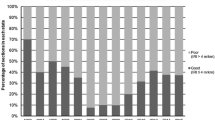Abstract
While it is impossible to estimate when a road section will collapse, the understanding of road section deterioration can help asset managers predict the condition of road sections and take appropriate actions for rehabilitations. Deterioration forecasting modeling is an essential element for an efficient pavement management system. Although the Pavement Management System (PMS) has been introduced and operated for optimal road maintenance since the late 1980s in Korea, some problems for accurate prediction of road deterioration remain due to the quality of pavement performance data and the different pavement structural, material and environmental conditions. In this paper, a methodology to estimate the Markov transition probability model is presented to forecast the deterioration process of road sections. The deterioration states of the road sections are categorized into several ranks and the deterioration processes are characterized by hazard models. The Markov transition probabilities between the deterioration states, which are defined by the non-uniform or irregular intervals between the inspection points in time, are described by the exponential hazard models. Furthermore, in order to verify the validity of the proposed method, the applicability of the estimation methodology presented in this paper is investigated by using the empirical surface data set of the national highway in Korea.
Similar content being viewed by others
References
Abaza, K. A., Ashur, S. A., and Al-Khatib, I. A. (2004). “Integrated pavement management system with a Markovian prediction model.” J. of Transp. Engrg., Vol. 130, No. 1, pp. 24–33.
Amemiya, T. (1985). Advanced Econometrics, Harvard University Press, Cambridge, MA.
Butt, A. A., Shahin, M. Y., Carpenter, S. H., and Carnahan, J. V. (1994). “Application of Markov process to pavement management systems at network level.” 3rd International Conference on Managing Pavements, TRB, Vol. 2, pp. 159–172.
Cesare, M. A., Santamarina, J. C., Turstra, C. J., and Vanmarcke, E. (1992). “Modeling bridge deterioration with Markov chains.” J. of Transp. Engrg., Vol. 118, No. 6, pp. 821–833.
Chung, S., Hong, T., Han, S. Son, J., and Lee, S. (2006). “Life cycle cost analysis based optimal maintenance and rehabilitation for underground infrastructure management.” KSCE J. of Civil Engineering, Vol. 10, No. 4, pp. 243–253.
Federal Highway Administration (FHWA). (1993). PONTIS technical manual, Publ. No. FHWA-SA-94-031, U.S. Dept. of Transp., Washington, D.C.
Gourieroux, C. (2000). Econometrics of qualitative dependent variables, Cambridge University Press.
Greene, W. H. (1997). Econometric analysis, 3rd. Ed., Macmillan, New York.
Guignier, F. and Madanat, S. (1999). “Optimization of infrastructure systems maintenance and improvement policies.” J. of Infrastructure Systems, Vol. 5, No. 4, pp. 124–134.
Jiang, M., Corotis, R. B., and Ellis, H. (2000). “Optimal life-cycle costing with partial observability.” J. of Infrastructure Systems, Vol. 6, No. 2, pp. 56–66.
Jiang, Y., Saito, M., and Sinha, K. C. (1989). “Bridge performance prediction model using the Markov chain.” Transp. Res. Rec. 1180, TRB, pp. 25–32.
Kim, S. and Kim N. (2006). “Development of performance prediction models in flexible pavement using regression analysis method” KSCE J. of Civil Engineering, Vol. 10, No. 2, pp. 91–96.
Lancaster, T. (1990). The econometric analysis of transition data, Cambridge University Press.
Lee, T. C., Judge, G. G., and Zellner, A. (1970). Estimating the parameters of the Markov probability model from aggregate time series data, Amsterdam, North-Holland.
Loizos, A. and Karlaftis, M.G. (2005). “Prediction of pavement crack initiation from in-service pavements: A duration model approach” J. of the Transportation Research Board, No.1940, TRB, pp. 38–42.
Madanat, S. M., Mishalani, R., and Wan Ibrahim, W. H. (1995). “Estimation of infrastructure transition probabilities from condition rating data.” J. of Infrastructure Systems, Vol. 1, No. 2, pp. 120–125.
Mishalani, R. G. and Madanat, S. M. (2002). “Computation of infrastructure transition probabilities using stochastic duration models.” J. of Infrastructure Systems, Vol. 8, No. 4, pp. 139–148.
Park, S. (2004). “Identifying the hazard characteristics of pipes in water distribution systems by using the proportional hazard model: 2. Applications.” KSCE J. of Civil Engineering, Vol. 8, No. 6, pp. 669–677.
Prozzi, J. A. and Madanat, S. M. (2004). “Development of pavement performance models by combining experimental and field data.” J. of Infrastructure Systems, Vol. 10, No. 1, pp. 9–22.
Shin, H. (2006). “Development of a semi-parametric stochastic model of asphalt pavement crack initiation.” KSCE J. of Civil Engineering, Vol. 10, No. 3, pp. 189–194.
Tobin, J. (1958). “Estimation of relationships for limited dependent variables.” Econometrica, Vol. 26, pp. 24–36.
Tsuda, Y., Kaito, K., Aoki, K., and Kobayashi, K. (2005) “Estimating markovian transition probabilities for bridge deterioration forecasting.” JSCE Journal, No.801/IV-73, pp. 69–82 (in Japanese).
Wee, S. and Kim, N. (2006). “Angular fuzzy logic application for pavement maintenance and rehabilitation strategy in Ohio.” KSCE J. of Civil Engineering, Vol. 10, No. 2, pp. 81–89.
Yang, J., Gunaratne, M., Lu, J. J., and Dietrich, B. (2005). “Use of recurrent Markov chains for modeling the crack performance of flexible pavements.” J. of Transportation Engineering, Vol. 131, No. 11, pp. 861–872.
Author information
Authors and Affiliations
Corresponding author
Rights and permissions
About this article
Cite this article
Kobayashi, K., Do, M. & Han, D. Estimation of Markovian transition probabilities for pavement deterioration forecasting. KSCE J Civ Eng 14, 343–351 (2010). https://doi.org/10.1007/s12205-010-0343-x
Received:
Revised:
Accepted:
Published:
Issue Date:
DOI: https://doi.org/10.1007/s12205-010-0343-x




